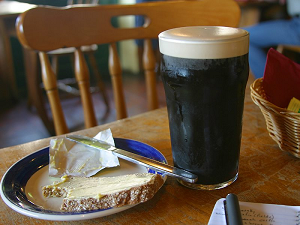
BeerA brief overview by William MathesonProvided you've seen at least one football game (any code will do), you are aware of beer - namely, that it is a drink brought down from the Rocky Mountains in a semi truck that helps beautiful people who appear in commercials attract members of the opposite sex. Some brew masters are loathe to share their ingredients and/or methods, as you'll discover if you poke around in the library on the Alexander Keith's brewery tour while the guide has his back turned. Fortunately, the general ideas behind beer making are open source and freely available. In many jurisdictions, it's perfectly legal to brew beer. In every other, it's probably being done anyway.
The biggest ingredient in beer is water. Two critical additions concern us: a starch source (for example, malted barley), and a yeast to ferment it. Optional but common additions include flavoring/stabilizing ingredients (chiefly hops) and clarifying agents or finings - vegetarians should note that isinglass finings are made from the swim bladders of fish. (Isinglass is typically used to clarify cask beer — kegged, canned, or bottled beer can be filtered without it. Ask your brewer, or hope for an inattentive tour guide.)
Let's look at six principal varieties of beer. |

A Bière de Garde, a type of pale ale (Source) |
Pale ale: Made using warm fermentation and pale malts (malts dried at low temperatures). The pale malts make for a lighter colored beer. |

A pint of Guinness with a slice of wheaten bread and butter. (Source) |
Stout: Brewed with roasted malts and slow-fermenting yeast. The roasting brings out additional flavor and color. We can't reccomend drinking stout in lieu of eating, but they are quite hearty. |

Mild Ale (Source) |
Mild ale: Beer with a malty palate, mildly hopped. Mainly darker colored, with a relatively low proportion of alcohol by volume. |

German wheat beer (Source) |
Wheat beer: Uses a high proportion of malted wheat grains, as opposed to malted barley grains (though many wheat beers do contain some proportion of barley). Can have a straw-like aftertaste. You might come to know why the Mesopotamians standardized on barley. |

Würzburger Hofbräu, a typical pale lager (Source) |
Lager: Together, lagers are the most commonly consumed beers in the world. These cold fermenting beers of European origin depend on a special hybrid yeast capable of cold fermentation. |

Three varieties of Lambic (Source) |
Lambic: These highly distinct beers, brewed only in one region of Belgium (the neccessary conditions are virtually impossible to reproduce elsewhere), are fermented using wild yeast. The long fermentation time necessitates a greater proportion of hops, thus aged, dried hops are used, as they have lost much of their bitterness. |
 |
| Possible long-term effects of ethanol, CH3-CH2-OH, the type of alcohol in our drinks (Source) |
Before we rush out to sample widely and drink deeply, let's not forget our health. Correlation does not equal causation, but notice that both social and career drinkers are associated with a reduced risk of developing kidney stones. This means that you'll likely be able to donate a kidney while they're swapping your liver.



